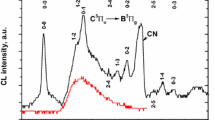Abstract
Thermoluminescence and emission of exo-electrons have been studied from uv-irradiated and non-irradiated samples of potassium, rubidium, cesium and sodium azides. The experimental data led to the conclusion that the luminescence phenomena observed at low temperatures are due to reactions involving “V” centers as well as the decomposition intermediates N −2 and N −4 . Above room temperature, the coincidence of luminescence and exo-electron emission suggests true thermoluminescence; however, excited nitrogen species are also believed to be responsible for part of the emission. At temperatures near the melting point luminescence and electron emission are associated with the thermal decomposition of the specimen.
Similar content being viewed by others
Author information
Authors and Affiliations
Rights and permissions
About this article
Cite this article
Mueller, H., Singer, G.D. Thermoluminescence and exo-electron emission from alkali azides. Z. Physik 182, 366–379 (1965). https://doi.org/10.1007/BF01383117
Received:
Issue Date:
DOI: https://doi.org/10.1007/BF01383117




